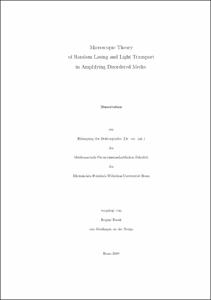Frank, Regine: Microscopic Theory of Random Lasing and Light Transport in Amplifying Disordered Media. - Bonn, 2011. - Dissertation, Rheinische Friedrich-Wilhelms-Universität Bonn.
Online-Ausgabe in bonndoc: https://nbn-resolving.org/urn:nbn:de:hbz:5N-24158
Online-Ausgabe in bonndoc: https://nbn-resolving.org/urn:nbn:de:hbz:5N-24158
@phdthesis{handle:20.500.11811/4920,
urn: https://nbn-resolving.org/urn:nbn:de:hbz:5N-24158,
author = {{Regine Frank}},
title = {Microscopic Theory of Random Lasing and Light Transport in Amplifying Disordered Media},
school = {Rheinische Friedrich-Wilhelms-Universität Bonn},
year = 2011,
month = mar,
note = {In the last decade Anderson Localization of Light and Random Lasing has attracted a variety of interest in the community of condensed matter theory. The fact that a system so inartificial as a thin layer consisting of dust particles, which have amplifying properties, can produce coherent laser emission, is of a simple elegance, which promises new insights in fundamental physics. The Random Laser consists of randomly distributed scatterers which have amplifying properties, embedded in an either amplifying or a passive medium. There is no need of an external feedback mechanism, like in the system of a conventional laser. Despite the striking chasteness of the effect, there are still vivid discussions about theory for the random laser, which has not been fully described yet. Whereas there are several attempts to enter the subject numerically by considering cavity approximations, this thesis is concerned with building a microscopically self-consistent theory of random lasing. In order to design this method we had to study light localization effects in random media including absorption and gain. We incorporated interference effects by calculating the Cooperon contributions and we found, that we reach Anderson localized states for passive media. Mapping this theory on a system which consists of laser active Mie-scatterers in a passive medium, we found that by incorporation of the Cooperon, we loose the Anderson localization again, but the system is still weakly localized, which is sufficient for the enhancement of population inversion and stimulated emission. The description of a random lasing system is completed by coupling the analytically derived microscopic transport theory to the laser rate equations of a four level laser and solving the system numerically self-consistent. Finally we develop a generalized method for describing light transport, multiple scattering and interference effects in a translationally non-invariant system of finite size analytically. The solution of this theory coupled to the rate equations gives us a closed theory to calculate transport and lasing properties of a random lasing slab geometry.},
url = {https://hdl.handle.net/20.500.11811/4920}
}
urn: https://nbn-resolving.org/urn:nbn:de:hbz:5N-24158,
author = {{Regine Frank}},
title = {Microscopic Theory of Random Lasing and Light Transport in Amplifying Disordered Media},
school = {Rheinische Friedrich-Wilhelms-Universität Bonn},
year = 2011,
month = mar,
note = {In the last decade Anderson Localization of Light and Random Lasing has attracted a variety of interest in the community of condensed matter theory. The fact that a system so inartificial as a thin layer consisting of dust particles, which have amplifying properties, can produce coherent laser emission, is of a simple elegance, which promises new insights in fundamental physics. The Random Laser consists of randomly distributed scatterers which have amplifying properties, embedded in an either amplifying or a passive medium. There is no need of an external feedback mechanism, like in the system of a conventional laser. Despite the striking chasteness of the effect, there are still vivid discussions about theory for the random laser, which has not been fully described yet. Whereas there are several attempts to enter the subject numerically by considering cavity approximations, this thesis is concerned with building a microscopically self-consistent theory of random lasing. In order to design this method we had to study light localization effects in random media including absorption and gain. We incorporated interference effects by calculating the Cooperon contributions and we found, that we reach Anderson localized states for passive media. Mapping this theory on a system which consists of laser active Mie-scatterers in a passive medium, we found that by incorporation of the Cooperon, we loose the Anderson localization again, but the system is still weakly localized, which is sufficient for the enhancement of population inversion and stimulated emission. The description of a random lasing system is completed by coupling the analytically derived microscopic transport theory to the laser rate equations of a four level laser and solving the system numerically self-consistent. Finally we develop a generalized method for describing light transport, multiple scattering and interference effects in a translationally non-invariant system of finite size analytically. The solution of this theory coupled to the rate equations gives us a closed theory to calculate transport and lasing properties of a random lasing slab geometry.},
url = {https://hdl.handle.net/20.500.11811/4920}
}






